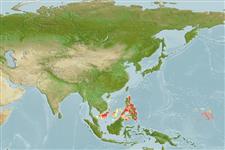>
Eupercaria/misc (Various families in series Eupercaria) >
Labridae (Wrasses)
Etymology: Paracheilinus: Greek, para = the side of + Greek, chaite = hair + Greek, odous = teeth (Ref. 45335).
More on authors: Randall & Lubbock.
Environment: milieu / climate zone / depth range / distribution range
Ecologia
marino associati a barriera corallina; distribuzione batimetrica 12 - 40 m (Ref. 9710). Tropical; 20°N - 5°N
Western Pacific: Philippines.
Size / Peso / Age
Maturity: Lm ? range ? - ? cm
Max length : 7.0 cm TL maschio/sesso non determinato; (Ref. 90102)
Short description
Chiavi di identificazione | Morfologia | Morfometria
Spine dorsali (totale) : 9; Raggi dorsali molli (totale) : 11; Spine anali: 3; Raggi anali molli: 9 - 10; Vertebre: 25. Scales with dark brown markings; yellow stripes on postorbital head, continuing onto thorax and abdomen; orange-red when fresh. Males more colorful and larger in size than females; color of males intensify during courtship. Males with its first 4-6 dorsal soft rays prolonged as filaments. Mouth small and oblique. Interrupted lateral line.
Found on bases of steep outer reef slopes, above rubble or coral (Ref. 9710). Found on rubble bottoms that are exposed to strong currents occasionally (Ref. 90102). Occurs in small groups (Ref. 2139) of mix sexes but females outnumber males (Ref. 90102).
Life cycle and mating behavior
Maturità | Riproduzione | Deposizione | Uova | Fecundity | Larve
Oviparous, distinct pairing during breeding (Ref. 205).
Randall, J.E. and R. Lubbock, 1981. Labrid fishes of the genus Paracheilinus, with descriptions of three new species from the Philippines. Jap. J. Ichthyol. 28(1):19-30. (Ref. 2139)
IUCN Red List Status (Ref. 130435: Version 2024-1)
Threat to humans
Harmless
Human uses
Can't connect to MySQL database (fbapp). Errorcode: Too many connections
